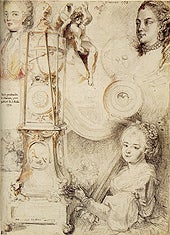Gabriel de Saint-Aubin (1724–1780)
October 30, 2007, through January 27, 2008
| |
 |
|
|
| |
Gabriel de Saint-Aubin (1724–1780), Sheet of Studies Including a Portrait of Mademoiselle Clairon, 1773, Black chalk, brush and colored washes, 22.9 x 16.8 cm, Musée du Louvre, Paris, Département des Arts graphiques, Livre des Saint-Aubin, fol. 21 |
|
|
The Frick Collection is pleased to present an exhibition devoted to the art of Gabriel de Saint-Aubin, one of the most original and innovative French artists of the Enlightenment. The fruit of many years’ research by curators on both sides of the Atlantic, the exhibition is the first major Saint-Aubin retrospective in more than eighty years and the first ever to include works from both European and North American collections. It is also the first such collaborative effort between The Frick Collection and the Musée du Louvre, where the show will be on view from February 27 to May 26, 2008.
The exhibition includes a prime selection of Saint-Aubin’s prolific and varied oeuvre, comprising some fifty drawings and a small but exceptional sample of his most memorable paintings and etchings. These selections demonstrate the artist’s achievement in a variety of thematic areas, ranging from ancient history to portraiture to the decorative arts, while highlighting the representations of contemporary Paris for which he is best known. Several fine examples of a unique aspect of his work — the small art sale and exhibition catalogues that he filled with hand-drawn illustrations in the margins of the printed texts — are also on view.
Gabriel de Saint-Aubin never left his native Paris. Born in 1724 into a family of skilled craftsmen, he was, by the age of twenty-three, teaching figure drawing in a school of architecture. He studied at the prestigious Royal Academy but failed to win the coveted Prix de Rome that would have provided him a scholarship to study at the French Academy in Rome. He is often said to have reacted to this disappointment by throwing aside all hopes of a traditional artistic career and hastening out into the thoroughfares of Paris to sketch everything in sight, living an errant, bohemian existence and succumbing increasingly to an obsession with drawing. In fact, despite his personal eccentricities, he was employed as an illustrator all his life.
It was through a combination of contributing forces, rather than one guiding motivation or lifelong obsession, that Paris became the dominant theme of Saint-Aubin’s formal and informal production. Unlike certain genre painters of the period, he was not a specialist who produced repeated versions of a few proven ideas. Instead, he drew on every aspect of his richly varied artistic background to express a more immediate fascination with things going on in Paris that were attracting differing degrees of local, national, and — sometimes — international attention. Developing an almost reportorial sense of current events, Saint-Aubin took it upon himself to record for posterity memorable occurrences such as calamitous fires, the appearance in Paris of foreign dignitaries, public courses on scientific subjects designed for the instruction and amusement of sophisticated laymen, theatrical performances, and lavish entertainments presented at fashionable pleasure palaces. Saint-Aubin’s most original contribution was to capture in paintings, finished drawings, and thumbnail sketches the art exhibitions and sales of his day, both as great events in the life of Paris and in all their fascinating documentary detail. Through his unusual professional background and the matchless power of his pictorial imagination, Saint-Aubin created a new and intensely personal way of portraying the city that was his world. The Frick’s exhibition will give viewers an opportunity to glimpse Paris as Saint-Aubin saw it some two hundred and fifty years ago.
Gabriel de Saint-Aubin (1724–1780) was organized for The Frick Collection by Colin B. Bailey, Peter Jay Sharp Chief Curator, and Kim de Beaumont, Guest Curator; the curators at the Musée du Louvre are Pierre Rosenberg, President-Director Emeritus, and Christophe Leribault, Chief Curator in the Department of Drawings.
The accompanying catalogue is available, in both English and French, in the Museum Shop.
Major funding for Gabriel de Saint-Aubin (1724–1780) has been provided by The Florence Gould Foundation. Additional generous support has been provided by The Christian Humann Foundation, the Michel David-Weill Foundation, and The Grand Marnier Foundation.
 |
|
The project is also supported, in part, by an award from the National Endowment for the Arts. |
|


